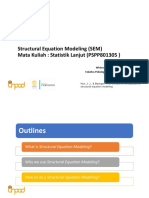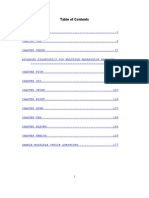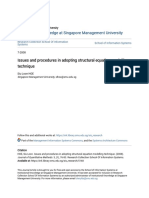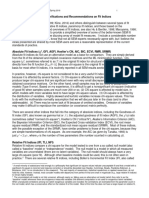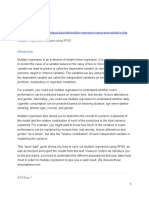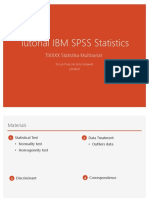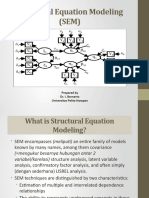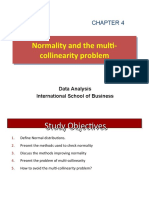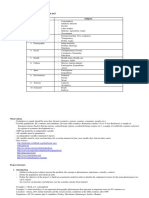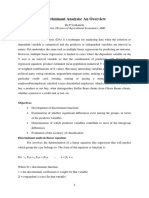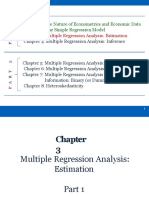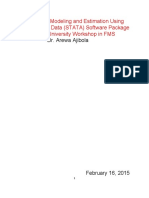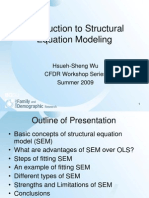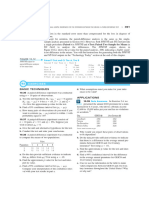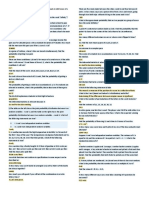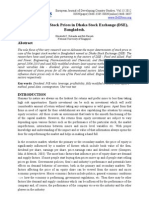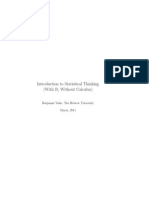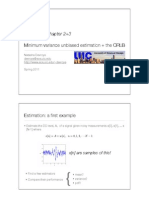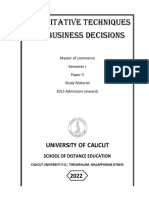Introduction to Structural Equation Modeling
Hsueh-Sheng Wu CFDR Workshop Series Summer 2009
�Outline of Presentation
Basic concepts of structural equation model (SEM) What are advantages of SEM over OLS? Steps of fitting SEM An example of fitting SEM Different types of SEM Strengths and Limitations of SEM Conclusions
�Basic Concepts of SEM
Link conceptual models, path diagrams, and mathematic equations together:
Conceptual model: More exercise leads to better physical health, which then increases quality of life Path diagram:
1
Exercise
Physical Health
Quality of Life
Equations:
Physical Health= 1 + 1 * Exercise+ 1 Quality of Life = 2 + 2 * Physical Health + 2
3
�Jargon of SEM
Variables in SEM
Measured variable Latent variable Exogenous variable Endogenous variable Error Disturbance
�Relation between Two Variables
A path with a single headed arrow one variable predicts the other variable one variable is the indicator of the other variable A path with a double-headed arrow means that two variables are correlated with each other No path means no direct relation between two variables
�Parameters in SEM
�Effects of One Variable on Another Variable
Direct effect Indirect effect Total effect
�Advantages of SEM over OLS
Control for measurement errors in observed independent variables, dependent variables, or both.
Analyze more than one dependent variables at a time Distinguish among direct, indirect, and total effects of variables Model how Xs influence Ys via other variables Test more complex models on three or more waves of longitudinal data
8
�Steps of Conducting SEM Analysis
Develop a theoretically based model Construct the SEM diagram Convert the SEM diagram into a set of structural equations Clean data and decide the input data type Determine the estimation method Run the model and evaluate goodness-of-fit of the model Modify the model Compare two models and decide if additional modification is needed
9
�Input Data Type
Raw data Correlation matrix Covariance matrix Covariance matrix and means Correlation matrix and standard deviations Correlation matrix, standard deviations, and means
10
�Estimation Methods
ML: Maximum likelihood estimation ULS: unweighted least squares estimation GLS: generalized least squares estimation
11
�Maximum Likelihood Estimation
Assume multivariate normality of observed variables Is commonly used with large sample size Parameter estimates are consistent, asymptotically unbiased, and efficient Estimates are normally distributed, which allows for testing statistical significance of parameters ML estimates are scale-free
12
�Unweighted Least Squares Estimation
Statistically consistent parameter estimates No distributional assumption for variables Possibly compute tests of significance for model parameter Item parameter estimates and fit index are scale dependent Parameter estimates are not asymptotically efficient No overall test of fit
13
�Generalized Least Squares Estimation
Parameter estimates are consistent, asymptotically unbiased, and efficient. Estimates are asymptotically normally distributed. Like ML, GLS estimates are also scale free. Use 2 test for model fit
14
�Criteria for Goodness-of-fit of the model
Overall model fit Chi-Square test (p-value greater than .05) Incremental fit indices Comparative Fit Index (CFI >= .90) Non-Normed Fit Index (NNFI >=.90) Residual-based Indices Root Mean Square Error of Approximation (RMSEA ,=.05) Standardized Root Mean Square Residual (SRMR <= .05) Root Mean Square Residual (RMR <= .05) Goodness of Fit Index (GFI >= .95) Adjusted Goodness of Fit Index (AGFI >= .90) Model Comparison Indices
Chi-Square Difference Test
Akaike (AIC) Bayesian Information Criterion (BIC)
15
�Modify the Model
Increase the overall fit of the model
Constrain some parameters to be 0 Set equal constrains for some parameters Add new paths among variables
Expected outcome
Good overall fit of the model The value of each estimated parameter is significantly different from 0.
16
�Comparison between Two Models
Nested models
Likelihood ratio test
Nonnested model
Akaike (AIC) Bayesian (BIC)
17
�An Example of SEM
Exercise increases physical health and mental health Social relation improves physical health and mental health Education enhances physical health and mental health Physical health and mental health influence quality of life Social relations may or may not have an direct impact on quality of life (hypothesis)
18
�Path Diagram A
1
Exercise
Physical Health
Social Relation
Quality of Life
Education
Mental Health
2
19
�Path Diagram B
1
Exercise
Physical Health
Social Relation
Quality of Life
Education
Mental Health
2
20
�Goodness-of-Fit for Diagram A
Chi-Square test: 2 = 0.757, DF =3, P=.8598 CFI = 1.000 RMSEA = 0 SRMR = 0.001 Akaike (AIC) = 9143.105 Bayesian (BIC) = 9206.324
21
�Result of Path Diagram A
Estimate Y1 ON X1 X2 X3 ON X1 X2 X3 ON Y1 Y2 X2 0.992 2.001 3.052 S.E. 0.043 0.045 0.045 Est./S.E. 22.979 44.618 68.274 Two-Tailed P-Value 0 0 0
Y2
2.935 1.992 1.023
0.05 0.052 0.051
59.002 38.556 19.869
0 0 0
Y3
0.507 0.746 1.046
0.02 0.02 0.072
25.491 37.914 14.54
0 0 0
Intercepts Y1 Y2 Y3 Residual Variances Y1 Y2 Y3 1.061 1.408 1.717 0.067 0.089 0.109 15.811 15.811 15.811 0 0 0 -1.064 -0.042 1.068 0.046 0.053 0.063 -23.059 -0.784 17.093 0 0.433 0
22
�Goodness-of-Fit for Diagram B
Chi-Square test: 2 = 177.068, DF =4, P=.0000 CFI = 0.958 RMSEA = 0.294 SRMR = 0.027 Akaike (AIC) = 9713.416 Bayesian (BIC) = 9376.420
23
�Result of Path Diagram B
Two-Tailed Estimate Y1 ON X1 X2 X3 ON X1 X2 X3 ON Y1 Y2 0.992 2.001 3.052 S.E. 0.043 0.045 0.045 Est./S.E. 22.98 44.62 68.27 P-Value 0 0 0
Y2
2.935 1.992 1.023
0.05 0.052 0.051
59 38.56 19.87
0 0 0
Y3
0.603 0.824
0.022 0.023
26.98 36.52
0 0
Intercepts Y1 Y2 Y3 Residual Variances -1.06 -0.04 1.145 0.046 0.053 0.074 -23.1 -0.78 15.41 0 0.433 0
Y1 Y2 Y3
1.061 1.408 2.443
0.067 0.089 0.155
15.81 15.81 15.81
0 0 0
24
�Results for Path Diagram A
1
(1.061 ) 0.992
Exercise
2.001 3.052
Physical Health
0.507 1.046
Social Relation
0.746 2.935 1.992
Quality of Life
Education
1.023
Mental Health
2
(1.408 )
3
(1.717 )
25
�Results for Path Diagram B
1
(1.061 ) 0.992
Exercise
2.001 3.052
Physical Health
0.603
Social Relation
0.824 2.935 1.992
Quality of Life
Education
1.023
Mental Health
2
(1.408 )
3
(2.443 )
26
�Alternative models
Exercise Education Social Relation Physical Health Quality of Life
Mental Health
Alternative Model 1
Physical Health Education
Exercise Quality of Life Social Relation
Mental Health
Alternative Model 2
�Different Types of SEM
Path model Auto-regressive model Growth curve model Hierarchical linear model Mixture model Latent class analysis
28
�Different Types of SEM (Cont.)
Factor analysis models
Confirmatory factor analysis Second-order factor models
Full structural equation models
Mimic model
Age
Love
Commitment
1 1 1
29
Gender Wealth
Passion
Intimacy
�A Few SEM Applications in JMF
Schoppe-Sullivan, Sarah J, Alice C. Schermerhorn, and E. Mark Cummings. 2007. Marital Conflict and Childrens Adjustment: Evaluation of the Parenting Process Model. Journal of Marriage and Family 69: 1118-1134. Vandewater, Elizabeth A. and Jennifer E. Lansford. 2005. A Family Process Model of Problem Behaviors in Adolescents. Journal of Marriage and Family 67: 100-109. Mistry, Rashmita S., Edward D. Lowe, Aprile D. Benner, and Nina Chien. 2008. Expanding the Family Economic Stress Model: Insights from a Mixed-Methods Approach. Journal of Marriage and Family 70: 196-209.
30
�An Example of LISREL Codes
LISREL codes for Schoppe-Sullivan, Schermerhorn, and Cummings (JMF 2007, Figure 1) DA NI=19 NO=283 MA=CM LA FI=data.txt KM FI=data.txt SD FI=data.txt SE 7 8 9 10 11 12 13 14 15 16 1 2 3 4 5 6/ MO NY=10 NX=6 NE=4 NK=1 LY = FI BE=SD PS=DI TE=SY LE PB-CON PP-CON P-WARM C-SYM LK M-CONFLI FI BE 2 1 BE 3 1 BE 3 2 VA 1 LX 1 1 LY 1 1 LY 4 2 LY 6 3 LY 9 4 FR LX 2 1 LX 3 1 LX 4 1 LX 5 1 LX 6 1 LY 2 1 LY 3 1 LY 5 2 LY 7 3 LY 8 3 LY 10 4 PD OU MI 31
�Strengths of SEM
Specify various models for different relations among variables, depending on theoretical frameworks Distinguish among direct, indirect, and total effect of variables Analyze the relations among variables controlling for measurement errors Comprehensive statistical tests for identifying and comparing different structural models
32
�Limitations of SEM
SEM does not establish causal orders among variables if the temporal order of these variables is unknown.
Missing data and outliers influence the covariance and correlation matrices analyzed.
33
�Limitations of SEM (Cont.)
A large sample size produces stable estimates of the covariance or correlation among variables, but it make the model easier to be rejected. There may be multiple equivalent models that fit data equally well. The number of parameters to be estimated cannot exceed the number of known values.
34
�Conclusions
SEM is a useful analytic technique in situations when independent variables, dependent variables, or both contain measurement errors. Even when your variables do not contain measurement errors, SEM allows for better testing theoretical links (i.e., paths) among variables. Available software: SAS, LISREL, Amos, EQS, and Mplus.
SAS is available on all computers in Williams Hall. LISREL is available in Hayes 025 Lab and Olscamp 207 Lab. Amos, EQS, and Mplus not supported by BGSU
35
�Conclusions (Cont.)
More readings about SEM:
Bollen (1989, Structural Equation Modeling) Kline (1998, Principles and Practice of Structural Equation Modeling) Kaplan (2000, Structural equation Modeling) Raykov & Marcoulides (2000, A First Course in Structural Equation Modeling)
If you encounter problems running SEM models, feel free to contact me (Hsueh-Sheng Wu, wuh@bgsu.edu, 419-372-3119).
36






